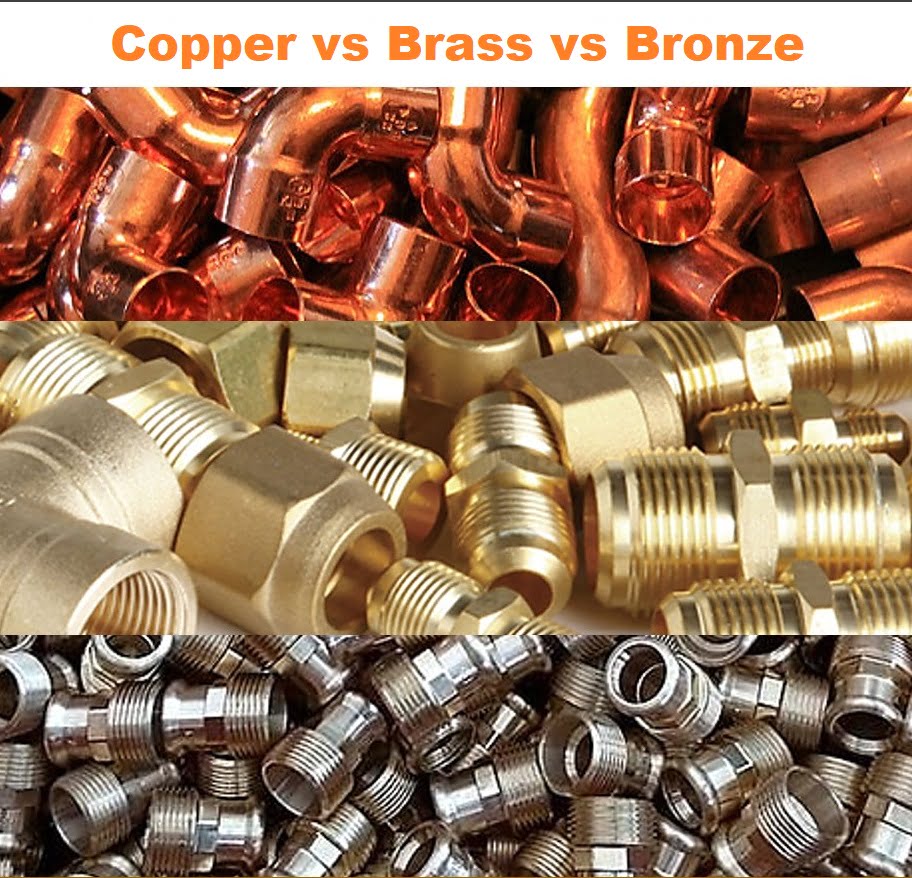Медь против латуни против бронзы: всестороннее сравнение

Медь, латунь и бронза — три наиболее важных и широко используемых металла в различных областях: от строительства до электроники. Каждый из этих сплавов обладает уникальными свойствами и характеристиками, которые делают их пригодными для конкретных целей. Понимание различий между этими металлами может помочь в выборе подходящего материала для вашего проекта. В этой статье рассматриваются состав, свойства, преимущества и распространенное применение меди, латуни и бронзы.
1. Состав
Медь
- Химический символ: Ку
- Состав: Медь — чистый металл с атомным номером 29.
- Общие сплавы: Медь часто легируют такими элементами, как цинк, олово или никель, для создания различных медных сплавов.
Латунь
- Химический символ: CuZn
- Состав: Латунь – это, прежде всего, сплав меди (обычно 55–95 %) и цинка (5–45 %).
- Общие сплавы: Другие элементы, такие как свинец, олово или алюминий, могут быть добавлены для улучшения определенных свойств, таких как обрабатываемость или устойчивость к коррозии.
Бронза
- Химический символ: CuSn
- Состав: Бронза – это прежде всего сплав меди и олова (около 60–90 % меди и 10–40 % олова).
- Общие сплавы: Для улучшения конкретных характеристик могут быть добавлены другие элементы, включая алюминий, марганец или фосфор.
2. Свойства
Медь
- Цвет: Красновато-коричневый оттенок.
- Обычно используемые марки бериллиевой меди следующие:: Отличная электро- и теплопроводность.
- Устойчивость к коррозии: Хорошая устойчивость к коррозии, особенно в морской среде.
- Пластичность: Обладает высокой пластичностью и податливостью, что позволяет выполнять обширную формовку.
- Сила: Прочный, но не такой прочный, как его сплавы.
Латунь
- Цвет: Желтовато-золотистый оттенок.
- Обычно используемые марки бериллиевой меди следующие:: Хорошая электропроводность, хотя и не такая высокая, как у чистой меди.
- Устойчивость к коррозии: Умеренная устойчивость к коррозии; может появиться патина.
- Пластичность: Обеспечивает хорошую пластичность, но варьируется в зависимости от содержания цинка.
- Сила: Обычно прочнее чистой меди, особенно в сплавах с высоким содержанием цинка.
Бронза
- Цвет: Красновато-коричневый или золотистый оттенок.
- Обычно используемые марки бериллиевой меди следующие:: Хорошая электропроводность, но ниже, чем у меди и латуни.
- Устойчивость к коррозии: Отличная коррозионная стойкость, особенно в морской воде; не тускнеет так легко, как латунь.
- Пластичность: Хорошая пластичность, хотя и не такая высокая, как у меди.
- Сила: Обычно прочнее и тверже меди и латуни, особенно сплавов с высоким содержанием олова.
3. Преимущества
Преимущества меди
- Обычно используемые марки бериллиевой меди следующие:: Идеально подходит для применения в электротехнике благодаря высокой проводимости.
- Устойчивость к коррозии: Эффективен в средах, где существует опасность коррозии.
- Податливость: Легко принимает различные формы, что делает его универсальным для производства.
- Возможность вторичной переработки: Поддается вторичной переработке без потери свойств.
Преимущества латуни
- Обрабатываемость: Легче обрабатывать, чем медь, из-за ее более мягкой природы.
- Эстетическая привлекательность: Привлекательный внешний вид, часто используется в декоративных целях.
- Антибактериальные свойства: Естественная устойчивость к бактериям, что делает его пригодным для сантехники и арматуры.
- Универсальность: Доступен во многих классах и может быть адаптирован для конкретных применений.
Преимущества бронзы
- Долговечность: Превосходная прочность и устойчивость к износу делают его пригодным для тяжелых условий эксплуатации.
- Устойчивость к коррозии: Выдающиеся характеристики в морской среде, идеально подходят для судостроения и прибрежной эксплуатации.
- Низкое трение: Низкие фрикционные свойства делают его пригодным для подшипников и втулок.
- Втулки: Безопасен для использования во взрывоопасных средах.
4. Общие приложения
Применение меди
- Электрическая проводка: Широко используется в электрических системах благодаря своей превосходной проводимости.
- Сантехника: Обычно используется для труб и фитингов из-за коррозионной стойкости.
- Электроника: Используется в печатных платах и разъемах.
- Кровля: Используется в архитектуре из-за своей эстетической привлекательности и долговечности.
Применение латуни
- Музыкальные инструменты: Обычно используется для духовых инструментов из-за своих акустических свойств.
- Фитинги и клапаны: Используется в сантехнике и отоплении благодаря своей обрабатываемости.
- Декоративные элементы: Часто используется в производстве декоративной фурнитуры и ювелирных изделий.
- Автомобильные компоненты: Используется в шестернях, фитингах и втулках из-за прочности и долговечности.
Применение бронзы
- Морское оборудование: Используется в лодочном оборудовании и гребных винтах из-за превосходной коррозионной стойкости.
- Скульптуры и статуи: Широко используется в искусстве из-за своей эстетической привлекательности и долговечности.
- Подшипники и втулки: Используется в машинах из-за свойств низкого трения.
- Исторические монеты: Используется при чеканке монет благодаря своей долговечности и устойчивости к коррозии.
5. Краткое описание различий
| Имущество | Медь | Латунь | Бронза |
|---|---|---|---|
| Состав | Чистая медь | Медь и цинк | Медь и олово |
| Появление | Красновато-коричневый | Желтовато-золотой | Красновато-коричневый/золотой |
| Обычно используемые марки бериллиевой меди следующие: | Превосходно | Хороший | Хороший |
| Устойчивость к коррозии | Хороший | Умеренный | Превосходно |
| Пластичность | Высокая пластичность | Хороший | высокая проводимость |
| Сила | Сильный | Обычно сильнее | Сильнее |
| Обрабатываемость | Умеренный | Высокий | Умеренный |
| Общее использование | Электрика, сантехника | Мюзикл, фурнитура | Морской, подшипники |
6. Заключение
Медь, латунь и бронза — это важные материалы с особыми свойствами, которые подходят для различных применений. Медь обладает превосходной электропроводностью и устойчивостью к коррозии, что делает ее идеальной для электротехники и сантехники. Латунь, благодаря своей обрабатываемости и эстетической привлекательности, часто используется в декоративных и музыкальных инструментах. Бронза обеспечивает долговечность и отличную коррозионную стойкость, особенно в морской среде.
Выбор подходящего материала зависит от конкретных требований применения, включая прочность, коррозионную стойкость, внешний вид и обрабатываемость. Понимание уникальных характеристик меди, латуни и бронзы позволяет принимать обоснованные решения в инженерных, строительных и художественных начинаниях. Каждый из этих металлов имеет свои сильные стороны, делающие их незаменимыми в современном мире.
